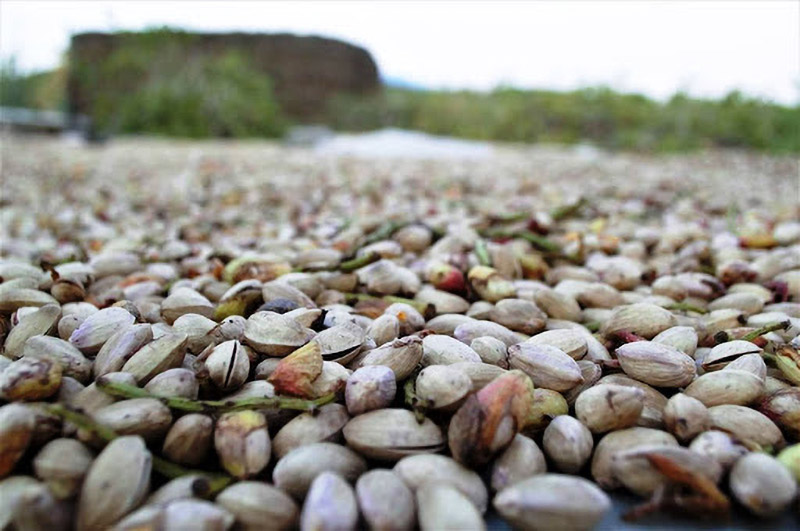Pistachio plants begin to produce some fruit after about ten years from grafting. Each plant produces from 5 to 15 kilograms of “tignosella” (this is the name given to the small and dried fruit) with a maximum of 20-30 kg.
In the years of non-harvesting, the even years, “of discharge” for growers, it is done the so-called green pruning (the buds in growth phase are removed by hand). The green pruning is a tradition which is lost in the mists of time, probably dating back to the Arab domination. It is handed down from father to son without interruption. Testimony of a culture, the farmer one, according to which, thanks to the “rest“, the plant absorbs from the lava soil the necessary substances to produce a fruit richer in aromas and full of unmistakable flavors.
Every two years ( uneven years) more than 30 thousand quintals of pistachios are harvested, representing just 1% of the world production but, for Bronte, the most significant economic element both for the cultivated area involved and for the relevant production value.
Also because of the impervious and steep environment in which the plant is cultivated, the danger of dispersion of the fruit among the “sciarelle” of the “lochi“, the harvest involves a considerable employment of expensive labor. It is still done in a totally manual way, directly from the trees, dropping the fruit into a container carried on the shoulder, or shaking the branches to collect the fruit on cloths spread at the foot of the plants or, in some cases, even with the use of an upside- down umbrella. A quick game of patient hands stained by the abundant resin of the branches, a long-awaited feast, and a hard work, to which with different tasks takes part all the family, women, grandparents, and children included.
After the harvesting, the fruit, by mechanical rubbing, is “shaken” (separated from the hull – the leathery involucre covering the fruit) and dried for 3-4 days under the sun in wide open spaces in front of the farmhouses.
In this way is obtained the pistachio in shell, locally called Tignosella, preserved by the producers, waiting to sell it, in dark and dry rooms. After two years of work and expenses, the hard work of the producer is over. Due to the price being too low, the expensive labor or a poor harvest, it is often not possible to recover the great use of physical and financial energies.
In 2000, for example, 60 percent of the product was lost to adverse weather conditions.
Shelling (the removal of the woody shell) is the next step.
It is carried out by mechanical processing, by cooperatives or local traders to whom the product is delivered or sold.
Today the two-year effort of producers ends with the “tignosella” (pistachio in shell): for shelling and peeling operations the fruit is delivered by producers to collection centers or sold to exporting companies.
These processes are imposed by importing countries and by the needs of confectionery and preserves industries.
As a matter of fact, thanks to its bright green color (a real trademark), Brontë pistachio is nowadays commercialized almost mainly in peeled condition.

Peeling, the removal of the endocarp (the thin reddish-purple skin) is done through a highly technological process by briefly exposing the fruit to high-pressure water vapor which causes the detachment of the endocarp.
A subsequent passage through the peeling machine, by rubbing the rollers at different speeds, removes the skin which is no longer adherent.
The green pistachios then pass through a complex circuit of low speed drying and from this into the electronic sorting machine which discards any berries of improper color.
The packaging of the dried product (with a humidity of 4-5%) is done in cartons of 12.5 kg. The processing cycle is completed.
In a cool and dry environment, the product preserves its color for several months, whereas it tends to fade after a prolonged stop.
It is for this reason that Cooperatives and exporters peel pistachios only on order and do not keep stocks of “peeled pistachios” as shelled pistachios – not yet peeled – can be kept in the refrigerator for more than one year without losing any of their peculiarities.
Two years of work and waiting have passed, but finally the result is the precious Bronte pistachio with its particular emerald green color and unmistakable organoleptic qualities.
The intense green color of the cotyledons, the elongated shape, the aromatic flavor and the high content in monounsaturated acid fats of the fruits, are hardly found in other production areas.
They make Bronte pistachios to have a clear preference over the product of American or Asian origin, mostly with round and yellow seeds, less uniformly green and often yellowish due to different climatic conditions, with a price significantly lower than the Bronte product.
Pistachios, once separated from the husk, must dry for two or three days under the sun to be then bagged, and stored in a dark and dry environment while waiting to be sold.



